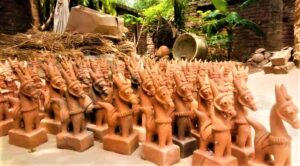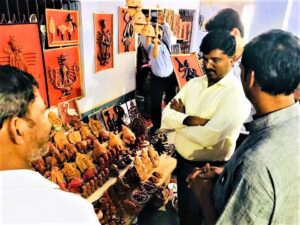The word Terracotta has originated from the Latin word ‘Terra Cota’, meaning ‘baked earth’. Terracotta is one of the foremost physical manifestations of human imagination in all of human history. This ancient art form characterised by figurines of Gods, Goddess, dancing girls, animals, tiles and toys has been the hallmark of Indian handicraft arts on the global platform since ancient times. 
Terracotta artifacts dating back to approximately 7000 BC have been uncovered from various archeological sites of the Indus Valley Civilization like Mohenjodaro, Birhana, Mehrgarh.
The state of Bengal has always been the at the forefront of art and culture in South Asian region, and terracotta art is no exception. The earliest evidence of terracotta art in Bengal is from the Mauryan age between 324 to 187 BC. Later excavations found terracotta art remains at sites in Bankura, Birbhum, Murshidabad and other rural places in Bengal.
Even today it is quite common to find the characteristic ’Bankura horses’ in majority of Bengali homes either in the form of an eight-feet high sculpture or a miniature in the living room.

There are more than 88 families involved in production of terracotta art currently in Bankura, West Bengal. “The demand remains high for horses as always. Couple of days back a few foreigners came and bought a few horses without even bargaining” states Nimai Charan Manna a local artist from Bankura district.
The potter’s wheel, has played a pivotal role in the development of terracotta art. Bengal’s ancient community of potters the kumbhakars produce everything from terracotta pots, toys, sculptures, wind chimes to temple panels.
The divine ties in Bengal’s terracotta pottery tradition continue with the creation of an auspicious piece called, ‘ghat’. These are well-known not only within the state but nationwide. In Panchmura village of Bankura, there are 50-60 kumbhakar (potter) families with an expertise in creating terracotta ‘ghats’. “During the Bengali festival season , we get bulk orders for ghats but rest of the time we are busy making horses, tiles and other statues’’ – Dilip Sadhukhan a local terracotta artist.
 For decades, the craftsmanship has been passed on from generation to generation, communities maintaining ethnic knowledge and expertise. “My grandfather Narayan Poddar used to be a terracotta kumbhakar (potter), then my father and all my uncles joined the family business, now I am doing it along with my four sons. Our family depends on the income of our artistic work only”, says Bhanu Poddar a 72 years terracotta artist.
For decades, the craftsmanship has been passed on from generation to generation, communities maintaining ethnic knowledge and expertise. “My grandfather Narayan Poddar used to be a terracotta kumbhakar (potter), then my father and all my uncles joined the family business, now I am doing it along with my four sons. Our family depends on the income of our artistic work only”, says Bhanu Poddar a 72 years terracotta artist.
Inability to keep up with modern technology and a slump in demand due to a global pandemic has made survival an even tougher challenge for these artisans. “Can you provide me some work please? We are very poor, we don’t get to eat properly, the income of the men in our family is not sufficient” pleads a teary eyed Surama Poddar, the 19 years old daughter-in-law of Bhanu Poddar.
Another young terracotta artist Shantu Khanra, from Panchmura village also was also found to be battling similar challenges, “Covid couldn’t defeat us but our dying business will kill us for sure. Everyday we are struggling to survive by working hard with the hope of worldwide demand picking up like before. Bangla is the only place where terracotta art and business still exists”.
 The local government’s attempts to encourage artisans for online marketing haven’t produced results due to lack of resources and infrastructure. Today, these artisans are desperately looking for technological, financial and infrastructural support from the government for developing their terracotta business online.
The local government’s attempts to encourage artisans for online marketing haven’t produced results due to lack of resources and infrastructure. Today, these artisans are desperately looking for technological, financial and infrastructural support from the government for developing their terracotta business online.
It is quite evident that without any intervention and support from the state, this glorious chapter of history of not just Bengal but of South-Asia might be lost forever and along with it the lives and livelihoods of millions of artisans who are a living proof of the rich cultural heritage of the Indian subcontinent.
Photographs by: Pulak Lahiri
Edited by: Raghujit S. Randhawa

